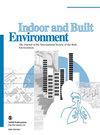Spatial distribution of PM2.5 concentration around high-rise residential buildings during peak traffic hours in autumn and winter seasons
IF 2.9
3区 工程技术
Q2 CONSTRUCTION & BUILDING TECHNOLOGY
引用次数: 0
Abstract
This research aimed to investigate the spatial distribution of PM2.5 in residential areas near major urban roads during the autumn and winter seasons. A traffic pollution distribution model was developed using ENVI-met software to predict the distribution of pollution in and around the residential area. The experimental results indicated that during peak hours, the concentration of PM2.5 inside the residential area exceeded 140 μg/m3. The simulations indicated a horizontal diffusion range of traffic pollution up to 300 m, with the most significant effects observed within a radius of 20 m where the pollutant concentration decreased from 131.6 μg/m3 to 93.5 μg/m3. The vertical diffusion of traffic pollution extended to approximately 100 m, with the highest impact observed within a distance of 22.5 m (7 floors). Furthermore, pollution diffused up to a height of 47.5 m near major urban roads, resulting in a decrease in the concentration of PM2.5 from 140 μg/m3 to 70 μg/m3. Quantitative comparisons showed that street pollution was higher in autumn than in winter, whereas pollution outside buildings near the street was higher in winter compared to autumn. Simultaneously, the impact of pollutants on human health was evaluated using the decrease in life expectancy (DLE) index. The results revealed a DLE of 13.16 years in areas with the highest pollution levels, while most residential areas had a DLE ranging between 3.2 and 3.88 years. These findings are significant in terms of raising awareness and providing valuable references for the development and planning of urban health initiatives.秋冬季节交通高峰时段高层住宅周围 PM2.5 浓度的空间分布情况
本研究旨在研究秋冬季城市主要道路附近居民区PM2.5的空间分布。利用ENVI-met软件建立交通污染分布模型,预测居住区内外的污染分布。实验结果表明,高峰时段居民区内PM2.5浓度超过140 μg/m3。模拟结果表明,交通污染的水平扩散范围可达300 m,在20 m半径范围内影响最显著,污染物浓度从131.6 μg/m3下降到93.5 μg/m3。交通污染的垂直扩散延伸到大约100米,在22.5米(7层)的距离内观察到的影响最大。此外,污染扩散到城市主要道路附近47.5 m的高度,导致PM2.5浓度从140 μg/m3下降到70 μg/m3。定量比较表明,秋季街道污染程度高于冬季,冬季街道附近建筑物外污染程度高于秋季。同时,利用预期寿命减少指数(DLE)评估污染物对人类健康的影响。结果显示,污染最严重地区的DLE为13.16年,而大多数居民区的DLE在3.2 - 3.88年之间。这些发现在提高认识方面具有重要意义,并为城市卫生倡议的发展和规划提供了宝贵的参考。
本文章由计算机程序翻译,如有差异,请以英文原文为准。
求助全文
约1分钟内获得全文
求助全文
来源期刊

Indoor and Built Environment
环境科学-工程:环境
CiteScore
6.40
自引率
25.00%
发文量
130
审稿时长
2.6 months
期刊介绍:
Indoor and Built Environment publishes reports on any topic pertaining to the quality of the indoor and built environment, and how these might effect the health, performance, efficiency and comfort of persons living or working there. Topics range from urban infrastructure, design of buildings, and materials used to laboratory studies including building airflow simulations and health effects. This journal is a member of the Committee on Publication Ethics (COPE).
 求助内容:
求助内容: 应助结果提醒方式:
应助结果提醒方式:


